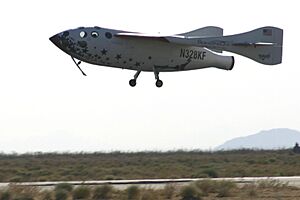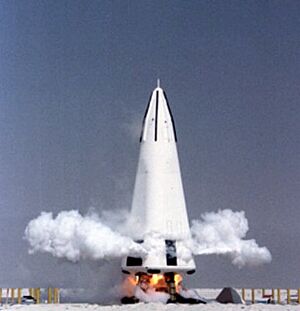Reusable launch vehicle facts for kids

A reusable launch vehicle is a rocket that has parts that can be used more than once. After launching a payload (like a satellite or astronauts) into outer space, some parts of the rocket return to Earth, get fixed up, and are flown again. This is a huge change from older rockets, where the entire rocket was thrown away after just one use.
The biggest parts that are reused are the large rocket stages, especially the first stage booster. By reusing these expensive parts, companies can save a lot of money on space launches. Think of it like using a reusable water bottle instead of buying a new plastic one every day.
To make a rocket reusable, engineers have to solve some tricky problems. The returning parts need to survive a fiery trip back through the Earth's atmosphere. They often have special heat shields to protect them. They also need systems to steer and slow down, like fins, parachutes, or even using their own rocket engines for a soft landing.
The idea of reusable rockets was popular in science fiction for a long time. The first real one was the Space Shuttle in the 1980s. Today, companies like SpaceX and Blue Origin have made reusable rockets a common sight, with rockets like the Falcon 9 and New Shepard landing regularly. This technology is making spaceflight cheaper and more accessible than ever before.
Contents
How Do Reusable Rockets Work?
Rockets can be either partially or fully reusable. Understanding the difference helps to see how this amazing technology works.
Partially Reusable Rockets
This is the most common type of reusable rocket flying today. In a partially reusable system, only some parts of the rocket are recovered. Usually, this is the first stage, which is the largest and most expensive part of the rocket.
After the first stage booster uses up its fuel, it separates from the rest of the rocket and begins its journey back to Earth. The second stage continues to push the payload into orbit. The booster then uses its engines and fins to steer itself to a landing spot, either on a landing pad on the ground or on a special ship at sea.
The Falcon 9 and Falcon Heavy rockets are famous examples of this. They have successfully landed and reflown their first-stage boosters hundreds of times.
Fully Reusable Rockets
A fully reusable rocket is the ultimate goal for many space companies. In this system, every part of the rocket is designed to be recovered and used again. This includes the first stage booster and the upper stage that carries the payload.
Achieving this is very difficult because the upper stage travels much faster and higher, making its return to Earth much more challenging.
SpaceX is developing a fully reusable rocket called Starship. It is made of two parts: the Super Heavy booster (the first stage) and the Starship spacecraft (the second stage). Both are designed to land back on Earth and be prepared for another flight. Starship has completed several test flights, successfully landing both the booster and the ship.
How Do Rockets Land Safely?
Getting a rocket back to Earth in one piece is a major challenge. Engineers use several clever methods to make it happen.
Surviving the Fiery Re-entry
When a rocket part falls back from space, it hits the atmosphere at incredibly high speeds. This creates a huge amount of friction and heat, enough to melt metal. To survive, rockets use a heat shield.
A heat shield is a protective layer that can handle extreme temperatures. Some are made of special tiles that absorb and block heat, like on the Space Shuttle. Others, like on the Starship, use stainless steel and a system that "sweats" fuel to cool the ship down.
Landing Methods
Once a rocket is through the hottest part of re-entry, it needs to slow down for a soft landing.
Parachutes and Airbags

This is one of the oldest and most reliable methods. Large parachutes open up to slow the vehicle down. This is how astronaut capsules like the SpaceX Dragon and the Russian Soyuz land. Sometimes, small rockets fire just before touchdown for an extra soft landing, or airbags inflate to cushion the impact.
Wings and Runways
Some reusable vehicles are designed like airplanes. They have wings that allow them to glide through the air and land horizontally on a runway. The most famous example is the Space Shuttle orbiter. This method allows for a very gentle landing but requires the vehicle to have heavy wings and landing gear.
Vertical Rocket-Powered Landing

This is the most modern and visually spectacular method. The rocket stage flips around and fires its own engines in a "landing burn" to slow down and land gently on its own landing legs. This is called a VTVL (Vertical Takeoff, Vertical Landing).
The Falcon 9 boosters are famous for their VTVL landings. This method requires precise computer control and extra fuel for the landing burn.
A Quick History of Reusable Rockets
The dream of reusable rockets has been around for a long time, but making it a reality took decades of work.
The Space Shuttle Era
In 1981, NASA launched the first reusable spacecraft, the Space Shuttle. It was a groundbreaking vehicle. The airplane-like orbiter could fly to space and land on a runway, and its two solid rocket boosters could be recovered from the ocean using parachutes. However, its large orange external fuel tank was thrown away on every mission.
The Shuttle flew for 30 years, carrying astronauts and building the International Space Station. The program showed that reusability was possible, but it was also very complex and expensive. Sadly, two missions, Challenger and Columbia, ended in accidents where the shuttles and their crews were lost. The program was retired in 2011.
A New Era of Reusability
In the 2000s and 2010s, private companies began to take the lead. The Ansari X Prize competition in 2004 encouraged this, and was won by SpaceShipOne, a reusable suborbital spaceplane.
The biggest breakthrough came from SpaceX. They developed the Falcon 9 rocket with a first stage designed for vertical landing. After many tests, they successfully landed a booster for the first time in 2015. Since then, they have made rocket reuse a routine part of spaceflight.
Other companies like Blue Origin with its New Shepard rocket and Rocket Lab with its Electron rocket have also developed their own reusable systems, starting a new and exciting chapter in space exploration.
List of Famous Reusable Launch Vehicles
Here are some of the most important reusable rockets, both past and present.
| Company | Vehicle | Reusable Part | First Launch | Status |
|---|---|---|---|---|
| Space Shuttle | Orbiter & Side Boosters | 1981 | Retired (2011) | |
| Falcon 9 | First Stage & Fairing | 2010 | Active | |
| Electron | First Stage | 2017 | Active, reflight planned | |
| Falcon Heavy | 3 First Stage Cores & Fairing | 2018 | Active | |
| Starship | Fully Reusable (Booster & Ship) | 2023 | In development | |
| Vulcan Centaur | First stage engines | 2024 | Active, recovery planned | |
| New Glenn | First stage | 2025 | Active | |
| Neutron | First stage (includes fairing) | 2025 | Planned |
List of Famous Reusable Spacecraft
These are vehicles that carry people or cargo in space and can be reused. They are often launched on top of another rocket.
| Company | Spacecraft | Launch Vehicle | First Launch | Status |
|---|---|---|---|---|
| Space Shuttle orbiter | Space Shuttle | 1981 | Retired (2011) | |
| Buran | Energia | 1988 | Retired (1988) | |
| X-37 | Atlas V, Falcon 9, Falcon Heavy | 2010 | Active | |
| Dragon | Falcon 9 | 2010 | Active | |
| Starliner | Atlas V | 2019 | Active | |
| Dream Chaser | Vulcan Centaur | 2025 | Planned |
See also
- Reusable spacecraft
- SpaceX reusable launch system development program
- List of private spaceflight companies
- Takeoff and landing


